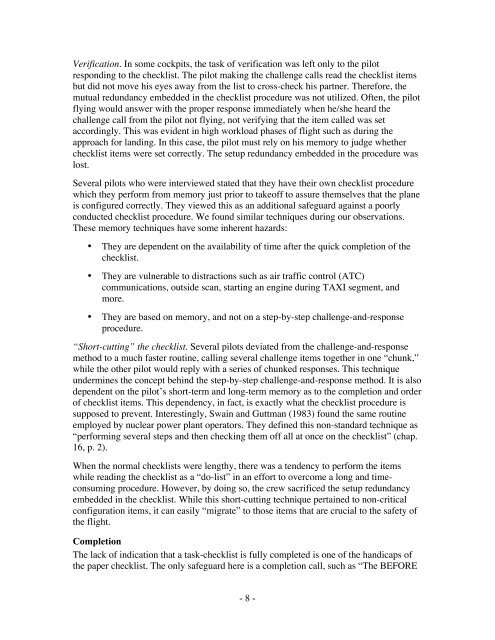COCKPIT CHECKLISTS: CONCEPTS, DESIGN, AND USE - NASA
COCKPIT CHECKLISTS: CONCEPTS, DESIGN, AND USE - NASA
COCKPIT CHECKLISTS: CONCEPTS, DESIGN, AND USE - NASA
You also want an ePaper? Increase the reach of your titles
YUMPU automatically turns print PDFs into web optimized ePapers that Google loves.
Verification. In some cockpits, the task of verification was left only to the pilotresponding to the checklist. The pilot making the challenge calls read the checklist itemsbut did not move his eyes away from the list to cross-check his partner. Therefore, themutual redundancy embedded in the checklist procedure was not utilized. Often, the pilotflying would answer with the proper response immediately when he/she heard thechallenge call from the pilot not flying, not verifying that the item called was setaccordingly. This was evident in high workload phases of flight such as during theapproach for landing. In this case, the pilot must rely on his memory to judge whetherchecklist items were set correctly. The setup redundancy embedded in the procedure waslost.Several pilots who were interviewed stated that they have their own checklist procedurewhich they perform from memory just prior to takeoff to assure themselves that the planeis configured correctly. They viewed this as an additional safeguard against a poorlyconducted checklist procedure. We found similar techniques during our observations.These memory techniques have some inherent hazards:• They are dependent on the availability of time after the quick completion of thechecklist.• They are vulnerable to distractions such as air traffic control (ATC)communications, outside scan, starting an engine during TAXI segment, andmore.• They are based on memory, and not on a step-by-step challenge-and-responseprocedure.“Short-cutting” the checklist. Several pilots deviated from the challenge-and-responsemethod to a much faster routine, calling several challenge items together in one “chunk,”while the other pilot would reply with a series of chunked responses. This techniqueundermines the concept behind the step-by-step challenge-and-response method. It is alsodependent on the pilot’s short-term and long-term memory as to the completion and orderof checklist items. This dependency, in fact, is exactly what the checklist procedure issupposed to prevent. Interestingly, Swain and Guttman (1983) found the same routineemployed by nuclear power plant operators. They defined this non-standard technique as“performing several steps and then checking them off all at once on the checklist” (chap.16, p. 2).When the normal checklists were lengthy, there was a tendency to perform the itemswhile reading the checklist as a “do-list” in an effort to overcome a long and timeconsumingprocedure. However, by doing so, the crew sacrificed the setup redundancyembedded in the checklist. While this short-cutting technique pertained to non-criticalconfiguration items, it can easily “migrate” to those items that are crucial to the safety ofthe flight.CompletionThe lack of indication that a task-checklist is fully completed is one of the handicaps ofthe paper checklist. The only safeguard here is a completion call, such as “The BEFORE- 8 -
















